Megan Edwards's Blog
October 11, 2021
You’re Invited!
 I’m thrilled to be sharing this invitation and hope to see you at what will be a delicious and entertaining evening!Imbrifex Books invites you to greet spring with a super-sized book launch and 26th anniversary party for RoadTripAmerica.com!Date & Time:
I’m thrilled to be sharing this invitation and hope to see you at what will be a delicious and entertaining evening!Imbrifex Books invites you to greet spring with a super-sized book launch and 26th anniversary party for RoadTripAmerica.com!Date & Time:Saturday, March 5, 2022
6:30 PM – 10:30 PM PSTLocation:
Divine Cafe at the Springs Preserve
317 South Valley View Boulevard
Las Vegas, NV 89107
View MapRSVP here!About this event
Seven featured authors will launch six great new books!
From Chesham, Buckinghamshire, UK, Marshall Hall presents Blimey, I’m Knackered! An American’s Survival Guide to British English From Boston, Massachusetts, Beth Castrodale presents her gripping suspense novel I Mean You No Harm From the open road, Ron Clements presents his groundbreaking guidebook A Sports Fan’s Guide to Route 66 From Reno, Nevada, Christopher and Elizabeth Barile present their new outdoor guide Base Camp Reno: 101 Hikes from Sage to Snow From Henderson, Nevada, Brett Riley presents his young adult debut Freaks From Las Vegas, Megan Edwards presents her long-awaited genre- and time-bending novel A Coin for the Ferryman Your master of ceremonies, award-winning poet Harry FagelMeet and greet a fascinating lineup of award-winning Imbrifex authors: A.D. Hopkins, H.G. McKinnis, Deborah Wall, Rick Quinn, Aaron Reed, and more. Plus, several Imbrifex Books authors whose books are in varying stages of production: Greg DeMars (Urban Fly Fishing Dallas & Ft. Worth), Michael Kozlowsky (Scarecrow Has A Gun), Robert McConnell (Fly Fishing Houston & SE Texas) and more.
Meet and greet the founders and contributors of RoadTripAmerica.com: Michael Roth, George Carey, Tom Herbertson, Pat Mount, Peter Thody, Megan Edwards, Mark Sedenquist, and more, celebrating more than a quarter-century of helping travelers the world over plan road trips in North America.
Meet and greet some very special guests who are party of the community of experts we work with everyday to produce books, e-books, audiobooks, and web sites: Peter Thody (Editor); Doug Symington (Freisens Corporation); Stan Ruiz (Spiderlink), Amanda Skenandore (author); Doug & Susan Kirby (Roadside America); Vicki Adang (Editor); Suzanne Campbell (Book Designer); Oksana Marafioti (author); and Jane Reilly (Smith Publicity) thus far. We are expecting several of our designers, editors, producers, engineers and marketing specialists to attend this party from around the USA.
And we eternally grateful for the support and friendship we have received from our family, our authors families and all of of our friends from around the globe. And to everyone who purchases books!
Enjoy complimentary gourmet appetizers, wine, and other beverages in the beautiful ambiance of the Divine Cafe at the Springs Preserve. A cash bar will also be available. The party is free and open to the public, but reservations are required. There’s plenty of free parking! We hope you’ll join us for an exciting and delicious evening! Make your reservation here.
The post You’re Invited! appeared first on Megan Edwards.
February 25, 2021
Nomadland: A Review

“I’m not homeless, I’m just houseless.”
This is Fern (Frances McDormand) talking, the central character in Nomadland, the film that explores the lifestyle of Americans who live on the road in vans, campers, trailers, and motor homes.
The line transported me back to the days I often said it myself. The first time was when I went to buy a toothbrush after my house burned down in a California wildfire. I’m not homeless, I remember thinking as I passed a homeless man sitting by the entrance to the drugstore. I’m just houseless.
After the fire, I lived “on the road” for what ended up being more than six years during the 1990s. So when Nomadland popped up on Hulu last week, I was interested. I will confess I was also glad I’d be streaming the film. I’ve never liked walking out of a theater, but it’s all too easy to do the equivalent with a flick of a remote. If Nomadland turned out to be preachy, boring, or irritatingly inaccurate, I’d cut my losses and switch to something else. I figured I’d give it half an hour at least.
France McDormand is easily the main reason I watched Nomadland all the way through, but I was also won over by the care the filmmakers took in crafting the script and choosing the locations. While the film doesn’t tell the whole story of American nomadism, it paints a credible picture of the part it showcases. For me, it was a trip down memory lane to see the encampments in Quartzsite, Arizona and the seasonal employees at work in places like Wall Drug, South Dakota.
While the film—to its credit—does not focus on it, the main difference between my years on the road and now is technology. When I hit the road, mobile phones were still mounted in vehicles. Email was an exciting new phenomenon, and modems were devices that needed telephones to work. People like Fern found employment by subscribing to print newsletters like Workamper News, which has united employers with traveling workers since 1987. They often joined groups like Escapees, an RV support club founded in 1978 that provides services like mail forwarding. These days, all nomads need are smartphones to go to workamper.com and escapees.com, the websites that have evolved along with technology and cell coverage.
While the movie, by including real nomads as fictionalized versions of themselves, projects a feeling of almost documentarian authenticity, it presents only a segment of the migratory population that travels the continent. Like birds, nomads belong to different flocks. One is the affluent group that travel in $300,000 vehicles and have no need for employment. Another includes professionals who have found they can work on the road as long as they have internet access. Yet another is made up of professionals whose work is transferable and who can accept short-term assignments around the country. Traveling nurses are a good example.
Right now, though I live in what nomads call a “stick house,” I enjoy following the travels of friends who live on the road. Take Ron and Patti Clements, for example. They’ve lived in an RV for three years now. Ron, a sports journalist, has written a book, A Sports Fan’s Guide to Route 66, that’s coming out in August. Patti works remotely full time. For as long as I’ve known them, I’ve admired Kimberly and Dennis Goza. They’ve lived on a roll for three decades. Their son grew up traveling the country with them as they performed in schools and libraries across the country as Act!vated Storytellers.
But back to the film. With Frances McDormand so capably inhabiting the persona of Fern, what emerges is a captivating story of personal and physical odyssey. After Fern makes her statement about being houseless but not homeless, she asks “Not the same thing, right?” The rest of the movie illustrates her point vividly, right up to the end, when Fern returns to the town she left when her husband died. Her old house is now an abandoned ruin in a ghost town. She can’t go home again, but by this time, she knows it’s not a place anyway.
The post Nomadland: A Review appeared first on Megan Edwards.
October 14, 2020
A Movie for a Quarantine Evening
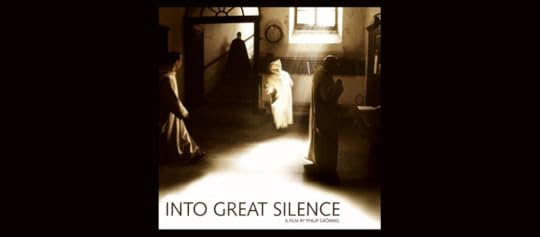
Like many people I know during this time of Covid, I have chosen to stay at home more than normal and to connect with friends and family through technology rather than in person. While I look forward to a time when gatherings and parties can once again take place without the shadow of pandemic hanging over them, I have found reasons to appreciate this unexpected social hiatus. I’ve finished a manuscript. I’ve begun a new one. I’ve had extra time for reading books, listening to music and podcasts, and streaming videos and movies. I’ve had time to slow down and soak up some things I doubt I would have had the patience for back in February.
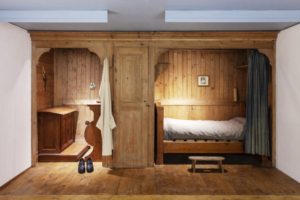 A replica of a cell in the Grand Chartreuse monastery
A replica of a cell in the Grand Chartreuse monasteryHere’s an example. I never would have found the time to watch Into Great Silence, a film I’ve known about for several years. This documentary explores life inside the Grand Chartreuse, a Carthusian monastery near Grenoble in the French Alps. I visited the monastery years back and learned about the silent, contemplative lives of its inhabitants at its visitor center and museum. Tourists aren’t permitted inside the community itself, but a replica cell provides a virtual glimpse of a Carthusian’s living quarters.
The Carthusians are responsible for providing the world with Chartreuse, the famous herbal liqueur with a color so distinctive it bears the same name. They long ago delegated the manufacture and distribution of Chartreuse to others, but the monks alone know the secret recipe. The global popularity of their liqueur means that the Carthusians are collectively very wealthy. Individually, however, they take vows of poverty.
Carthusian monks are contemplatives, meaning that they spend most of their waking hours in prayer and meditation. They are idiorhythmic, meaning that they don’t even eat together. While they do assemble for church services, and they do allow themselves occasional days for recreation, for the most part, they spend their lives in what might be described as voluntary quarantine.
Into Great Silence, the film that documentarian Philip Gröning was finally allowed to make after seeking permission for sixteen years, was released in 2007. It’s now available through Kanopy, the streaming service supported by public libraries and universities. When I discovered I could stream the film using my library card, I knew I would never have a better chance to get a peek inside the Grand Chartreuse and at the men who call it home.
Gröning lived in the Grand Chartreuse for six months in 2002 and 2003. He filmed by himself, using only natural light. He then spent nearly three years editing what became a finished movie nearly three hours in length. While a few subtitles provide some information, there is no spoken commentary, and there are no added sound effects.
And of course, there’s no plot. The only hint of story arc comes from images of snowy winter slowly giving way to an achingly beautiful alpine spring. I was riveted for the first twenty minutes. I felt like a voyeur looking into a private and alien world. Then, about half an hour in, I started feeling just a tiny bit bored. An hour in, I was fidgety bored. Another fifteen minutes, and I grabbed my phone. I kept watching, though, and soon I set my phone aside. I found myself unexpectedly re-mesmerized by the patient dedication of the monks to the repetitive quiet practice they had chosen for their lives. The second half of the film flew by, while at the same time feeling endless.
Rather than telling me what life is like inside the Grand Chartreuse, the filmmaker took me there. The film did not offer a virtual reality experience, but I think it did something even more extraordinary. It successfully drew me in to a virtual mental reality. It makes me wonder what March of the Penguins would be like with Morgan Freeman’s voice muted. Would I feel as authentically like a penguin as I did a French monk?
Perhaps that’s a question to be answered some other quarantine evening. In the meantime, I’m grateful to have had the time and opportunity to get a tiny taste of the contemplative life the Carthusians have been espousing for nearly a millennium. Into Great Silence is a unique reminder of the benefits to be derived from shutting up, slowing down, and staying the course.
The post A Movie for a Quarantine Evening appeared first on Megan Edwards.
September 1, 2020
Vegas Like a Local: Terms and Phrases

Now that I’ve lived in Las Vegas a couple of decades, it’s easy for me to forget the words and phrases I was slightly baffled by when I first arrived. I’ve already posted a list of local nicknames for places around the valley. Here are a few other terms that might come in handy if you want to sound like a local.
Comp: Maybe this word has found its way into the national vernacular, but it’s been a local term in Las Vegas since casinos first decided to reward their high rollers. Short for “complimentary,” it’s used as both noun and verb. A “comp” in a casino can be anything from a drink or a meal to a show ticket or a room. Around town, I’ve heard the word used for something given or received without cost to the recipient. “My dentist comped me this filling.” It’s also used in place of “on the house.” “Your money’s no good. This drink is a comp.”
Dark: This describes the day or days that a show or regularly scheduled event is not occurring. “That show’s dark on Mondays” does not mean its content is a downer one day a week. It means you should look for alternate forms of entertainment, which is what the performers do on their shows’ “dark” days.
Feather Show: This term refers to the spectacular revues that used to attract crowds to the showrooms on the Strip. Among the most famous were the Stardust’s “Lido de Paris” and the Tropicana’s “Folies Bergere.” Renowned for their elaborate staging and costumes, topless dancers, and, of course, feathers, they went extinct in 2016 when “Jubilee!” at Bally’s closed after a 35-year run.
George: This is a term used mainly by dealers in casinos, but it’s broken out into the wider community, too. A George is a generous tipper. I’ve also heard it used to mean “all around good guy.”
Graveyard: Everybody knows that a “graveyard shift” is the one in the middle of the might. In Las Vegas, the term shows up in some additional contexts. A “graveyard special” is usually a cheap breakfast in a casino cafe available from midnight or so until 6:00 a.m. Perfect for after you go “graveyard bowling!”
My Friday: The full phrase is often, “Today’s my Friday,” meaning “I’m starting my weekend, even though it’s Tuesday.” This could be a common phrase in other hospitality-centric cities, too–anyplace a lot of the the locals are working when the visitors are playing, e.g. real weekends.
Nude Dresser: This is just one example of the kinds of specialized professions unique to Las Vegas. If “nude dresser” sounds like an oxymoron to you, it’s because you don’t realize what it takes to get a nude out on stage. She may look nude, but somebody backstage is keeping track of her rhinestones and g-strings. While nude dressers were more common during the age of feather shows (see above), they are still around, taking care of performers in other kinds of productions. Feathers may be out of style at the moment, but nudity–or perceived nudity–never gets old.
Toke: Short for “token of my appreciation,” a toke is a tip. The term is commonly used by dealers. Does “One toke over the line” mean a tip on a craps table? No.
That’s my list for now. If you can think of other Vegas-isms, I’d love to know about them.
The post Vegas Like a Local: Terms and Phrases appeared first on Megan Edwards.
August 25, 2020
Vegas Like a Local: Places and Points of Interest
 A Glossary of Local Names for Las Vegas Places
A Glossary of Local Names for Las Vegas PlacesMaps provide names for places and landmarks, but they don’t let visitors in on local secrets, like what those names might mean or the alternative monikers favored by residents. Here is an incomplete list of some of the names locals use in Las Vegas for neighborhoods, streets, and points of interest. If you’d like to add to this list, please leave a comment!
D.I.: Desert Inn Road. The hotel Howard Hughes owned and once called home no longer exists, but the memory lives on in the street name.
Glitter Gulch: Now known as “The Fremont Street Experience” or, more casually, just “Fremont Street,” You’ll still hear long-time Las Vegans refer to these casino-lined blocks as “Glitter Gulch.” In the same breath, they are likely to lament the addition of “that awful canopy” and tell you how they used to cruise Fremont in their El Camino.
Hendertucky/Hooterville: Henderson’s old town. It has an adorable main street flanked by neighborhoods of small houses dating back to World War 2. Be careful how you use either term. They are pejoratives unless you live there.
Las Vegas Wash: This twelve-mile channel funnels the Vegas Valley’s runoff water into Lake Mead. The wetlands created by the wash are home to all sorts of birds and animals, including–according to reports–dam-building beavers.
Naked City: The neighborhood “behind the Stratosphere.” “Behind” means “west of.” The story goes that this used to be where all the showgirls lived, and they liked to sunbathe topless. The showgirls are gone, but the name lingers.
Neon Boneyard: Historically, this was the enclosure maintained by the Young Electric Sign Company to store all the old neon signs when they were retired from active duty. It’s now part of the Neon Museum.
Ninth Island: This is what Hawaiians call Las Vegas. It’s surprising, but since more than 50,000 Hawaiians call Las Vegas home, it shouldn’t be.
Over the hump: The whole phrase has a nice rhyme in it: “over the hump to Pahrump.” To get to Pahrump, you have to traverse the Spring Mountains via Highway 160 and Mountain Springs Summit. Why? To get to Nye County and the brothels, of course.
Rainbow curve: This is the benign name for the intersection of Rainbow Boulevard and U.S. Route 95. Because of its dangerous reputation, this junction is also sometimes called “Dead Man’s Curve.”
Spaghetti Bowl: An aerial view of the interchange that connects Interstate 15, U.S. Highway 93, U.S. Highway 95, and Martin Luther King Boulevard shows how it got its nickname. It’s a noodly tangle where daily rush hour traffic jams occur.
Summerlin: This large master-planned community on the northwest side of the City of Las Vegas sits on land once owned by Howard Hughes and is named after his grandmother. If it has a nickname, I haven’t heard it.
Sunrise Mountain: This is a little confusing, because while there is a peak called Sunrise Mountain on the east side of the Las Vegas Valley, its taller neighbor is regularly confused with it. The taller peak’s real name is Frenchman Mountain. Just say “Sunrise” for both, and everyone will know what you mean.
Test Site: This is localspeak for the Nevada National Security Site, which was known as the Nevada Test Site until 2010. It’s about 65 miles northwest of Las Vegas, far enough to be considered the middle of nowhere by folks in Washington DC, but close enough to the city that the mushroom clouds generated by nuclear bomb testing back in the ’50s could be seen from downtown.
The Lakes: If somebody claims to live at “The Lakes,” they probably mean the two-square-mile community on the west side of Las Vegas built around some man-made lakes. They could also mean Desert Shores, another community built around some manufactured lakes. But if they say “the Lake” (singular), they probably mean Lake Mead. Unless they mean Lake Las Vegas, another manufactured lake community in Henderson.
Tunnels: If someone talks about “the tunnels” in Las Vegas, they are most likely referring to the flood control channels that form a network under the city. Homeless people live in some of the more accessible ones, a practice that can be life-threatening when rainstorms occur, either locally or in the mountains.
Tule Springs: This beautiful oasis was once home to Tule Springs Ranch, where people came to live just long enough to establish Nevada residency and obtain a quick divorce. Now part of Floyd Lamb State Park, the area is still known locally as Tule Springs.
Westside: These days, if someone refers to Las Vegas’s west side, they probably mean any or all of the communities on the west side of Interstate 15. In decades past, the term referred very specifically to the African-American neighborhood northwest of the Strip bounded by Carey Avenue, Bonanza Road, Interstate 15, and Rancho Drive.
If you have additions or corrections, please leave a comment!
The post Vegas Like a Local: Places and Points of Interest appeared first on Megan Edwards.
August 18, 2020
This Little Piggy
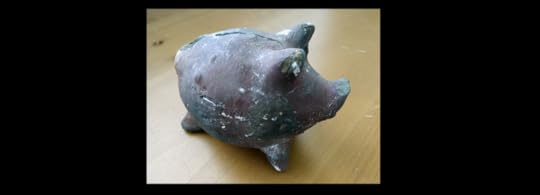
The piggy bank pictured above is not large, not beautiful, and not even serviceable. The slot on its back intended to accept coins is too narrow. It wasn’t too narrow when I bought the pig many years ago in the central market in San José, Costa Rica. I was grocery shopping with my mother, which sounds like a mundane task, but in that huge and bustling market, it was anything but. In addition to heaps of bananas, piles of papayas, baskets of green coconuts, women making tortillas, and men whacking up sides of freshly slaughtered beef, there were parrots and monkeys and fish. The smells ran the gamut from disgusting (the beef) to sublime: fresh hot tortillas wrapped in banana leaves. I never missed a chance to go to the market, and I always took my allowance. I usually spent it on candy, but one day I chose this little pig instead.
“You know what happens to pigs like that, don’t you?” my mother asked me.
“You fill them with coins?” I said.
“Yes. And what do you do when it’s full?”
“Take them out and buy something!”
“Turn the pig over,” Mom said.
I did, expecting to find a plugged hole on its underside, like every other piggy bank I’d ever seen. This pig’s belly was smooth. I stood there as realization dawned.
“I’d have to break him?” I asked.
“Either that, or set him outside in the rain. He hasn’t been fired, so he would melt.”
I decided then and there that this little pig was not ever going to get fed or get wet. When I got home, I set him on a shelf and forgot about him until my mother, not long afterward, decided she wanted to take home a special kind of souvenir from Costa Rica.
 As anyone who has toured Costa Rica knows, the country takes pride in its famous painted oxcarts. My mother decided to hire one of the artists to paint oxcart designs on several pieces of furniture, including a headboard and a cabinet. I watched the man paint for a couple of days. It was mesmerizing to see bright floral and abstract designs flow from his brushes. Aside from a few pencil lines to keep things centered, he painted freehand.
As anyone who has toured Costa Rica knows, the country takes pride in its famous painted oxcarts. My mother decided to hire one of the artists to paint oxcart designs on several pieces of furniture, including a headboard and a cabinet. I watched the man paint for a couple of days. It was mesmerizing to see bright floral and abstract designs flow from his brushes. Aside from a few pencil lines to keep things centered, he painted freehand.
The morning of his last day at our house, I pulled together my allowance money and asked the artist if he could work his magic on my pig. The man refused my coins, but he turned my pig into a work of art. It went back on its shelf, now a lovely shade of blue and decorated with bright red and orange flowers and curlicues.
My pig wore that beautiful exterior for the next thirty years, traveling with me back to the United States, through high school, college, and a trainer marriage. He stayed safely in storage while I lived in Europe, and reemerged when I married again. My well-traveled little pig had already survived a lot, but his real test was yet to come.
In late October, 1993, Santa Ana winds turned a campfire on a southern California hillside into a raging firestorm. The house I shared with my new husband was one of hundreds to burn. When we returned to the smoking remains the next day, it was obvious that nothing much had survived. When things cooled down enough, we sifted through the ashes. This little pig was one of the few items that emerged intact from the conflagration.
It’s no longer a lovely example of Costa Rican oxcart painting. It’s just a little discolored clay piggy bank whose slot is too narrow to accept any currently minted coins. If someone else had been sifting through the remains of my home, this little piggy would not have been worth a second look.
Since I know his story, here’s what I think he’d like us to know:
Whatever doesn’t kill you makes you stronger. I have always disliked this aphorism because it’s so often untrue. Some things leave you horribly damaged but stop short of killing you. In the case of this pig, however, the fire that wiped out so many other things did indeed make him stronger. He can go out safely in a rainstorm now.
Beauty is in the eye of the beholder. Or, possibly more accurately, in the memory of the owner. When you look at my piggy, you’re only seeing the latest version. I see beautiful flowers, and I smell hot tortillas wrapped in banana leaves.
A story adds value. This little piggy is not worth any money. He’s priceless.
The post This Little Piggy appeared first on Megan Edwards.
August 3, 2020
Writing Las Vegas
 Some of the oldest cities in the world were built in deserts. Las Vegas is not one of them.
Some of the oldest cities in the world were built in deserts. Las Vegas is not one of them.Incorporated in 1905, it is the only major American city founded in the twentieth century. Having survived an infancy that easily could have killed it, it’s now enjoying a lively adolescence. Like teenagers everywhere, it knows how to startle and offend. It wears eyebrow-raising outfits and drinks too much. It smokes, gambles, and stays up all night. It’s got a “wild child” reputation to maintain, and it spends a lot of time and energy doing it.
Like a real teenager, Las Vegas also has a side that it chooses to keep under wraps. It goes to church, the library, and the symphony. It conserves water. It worries about what other people think, and it wonders what it’s going to do when it grows up.
When I first decided to create a character from Las Vegas, I knew only about the city’s “Glitter Gulch” persona. Until I arrived to take a closer look, I had no idea what that dazzling veneer concealed. I certainly had no inkling that the city underneath would beguile me with its multifaceted personality and unique history.
I’m not alone in finding Las Vegas an alluring setting. More than a thousand other authors have also crafted stories set here, and the number keeps rising. As the city grows and matures—and as more writers call southern Nevada home—the stories that emerge explore layers, nooks, and corners the neon never illuminates. Put simply, real people live here and lead real lives. Las Vegas is like any city in America, and it’s also like no other. Like the desert surrounding it, it’s a place of contrasts and extremes.
I arrived here twenty years ago for a six-week stay. I thought that would be easily long enough for me to provide my fictional character with an authentic Las Vegas experience. I was wrong in ways I am even now still discovering. Not only is Las Vegas not the city I thought it was before I came, it’s not the same city it was ten years ago. We can all only wonder what it will be like after another decade. I hope I’ve captured a bit of real Vegas in my fiction, even as it moves on to its next phase. A part of me hopes it never grows up.
The post Writing Las Vegas appeared first on Megan Edwards.
December 19, 2019
Another Gift of the Magi
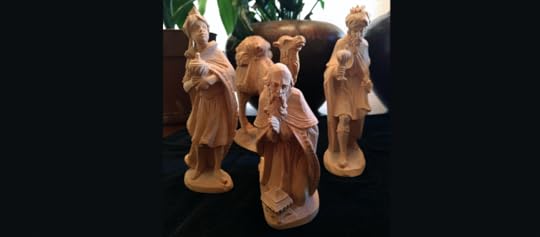
Every Christmas, I like to read O. Henry’s timeless story about two people who each want to give the other the best Christmas gift ever. They fail in the sweetest way possible, and the story always brings a tear to my eye, even though I’ve read it dozens of times.
As I unwrapped my Christmas crèche this year, I recalled my own story about the wise men. It happened back in 1993, when I was living in a small guest house in San Gabriel, California.
My husband and I had moved into the guest house after our own house and just about everything else we owned had burned in a wildfire at the end of October. We weren’t thinking about Christmas much. We were mostly thinking about what we were going to do in the wake of a life-changing event.
A small box arrived in the mail one day in mid-December. I opened it, wondering as I did who had sent us something from Germany. Nestled amid some tissue paper and excelsior were three hand-carved wooden figurines. It took me a minute, and then I remembered. Of course! The wise men!
In 1990, Mark and I had taken a trip to Europe. The highlight was a visit to Oberammergau, where friends were living at the time. They introduced us to their good friend, one of Oberammergau’s world-famous wood carvers. We decided to participate in a lovely German Christmas tradition: to build a crèche one year at a time.
The first year, we received Mary, Joseph, and the baby Jesus in a manger. The next year, a shepherd arrived, followed by two sheep and a donkey. In 1993, when the last thing on our minds was Christmas decorations, it was time for the three wise men.
That year, they stood on the counter in our little guest house alone, each one holding a gift for a baby that wasn’t there.
In the years that followed, we slowly rebuilt the crèche with replacement figurines from Germany. We’ve now got a full tableau, including a camel and an angel.
Every year, when I unwrap each little statue, I remember the year it seemed like the wise men had come to the wrong house. Sorry, guys, I used to think. Your star has led you astray.
But now I know they weren’t misguided after all. They showed up right when we needed them most, when we needed to be reminded that Christmas comes no matter what, and a new year after that. That year, the wise men themselves were the gift of the magi.
The post Another Gift of the Magi appeared first on Megan Edwards.
May 15, 2019
My Life as a Three-Legged Dog

A while back, I was working on a story about an animal shelter in Las Vegas. While talking to the director, he mentioned that an abandoned three-legged dog had just been brought to the shelter.
“Oh, how sad,” I said. “What are his chances?” I was thinking that a dog with such a disability might not be very attractive to potential owners.
“Oh, he’ll be gone before the day is over,” the director said.
He must have read the look on my face, because he quickly continued, “Oh, no! I mean he’ll be adopted. Dogs like that are snapped up fast.”
Well, I’ll be darned, I thought. The dog with a missing leg had an amazing advantage over a dog with all four. At an animal shelter, having only three legs was practically a super power.
This was food for thought, because I’m a three-legged dog myself. I was born with something called amniotic band syndrome. If you haven’t heard of it, it’s a trauma that occurs in the womb. For reasons yet to be determined, strands of tissue become detached from the uterine wall. This alone causes no problems, but if these strands get wrapped around the developing fetus, it’s a different story. Imagine wrapping dental floss around a baby’s wrist and leaving it there. The child grows, but the floss does not. Left in place, the floss would eventually amputate the baby’s hand. The effects of ABS range from minor (a toe is lost) to catastrophic (death by strangulation).
In my case, the bands would have amputated both of my hands and one of my feet. I say “would have” because I happened to be born in a hospital where one of the world’s foremost hand surgeons was practicing. He couldn’t save all my fingers and toes, but I did grow up able to walk and write.
In other words, I grew up a little like a three-legged dog. My physical anomalies are not something I can completely hide. Whenever I went to a new school, which was often because my family moved a lot, I had to put up with stares and whispers and questions. Fortunately, this period was usually short. I’d make some friends who seemed to stop noticing my differences, or at least stopped commenting on them.
Although I would settle into a comfort zone, I never felt as though my disability gave me an advantage. I couldn’t run fast, so I was a drag on any team I was assigned to. And when it came to music lessons, piano was out of the question. I did manage to play French horn for a brief while, and later a drum in a bagpipe band. I didn’t suffer, just felt some limitations. But don’t we all? And I was really good at art and writing. I concentrated on the things I could do, and tried not think about the things I couldn’t. Again, don’t we all?
All through school, I never once thought that my differences provided me with any positive benefits. They were just inconveniences that occasionally prevented me from doing things that I wished I could but knew I couldn’t. At first it was piano and sports. Later it was any kind of competition that involved physical appearance. I knew I’d never have a chance in a beauty contest. In addition to perky breasts and a slender waist, prom queens and Miss Americas always have ten fingers and ten toes and legs that are the same length. I shrugged it off and did science fairs and writing contests and outdoor survival skills competitions. Again, I didn’t suffer. I just looked for options open to me.
Only as an adult did it dawn on me that my so-called disability actually had provided me with advantages. As a teenager, I thought it had prevented me from being a beauty queen. As an adult, I realized it had saved me. And once I had that thought, others rushed into my head in a torrent. I couldn’t wear those strappy stiletto sandals, but I also didn’t have to. Someday, I might add up all the money I’ve saved on shoes, even though the customized shoes I do wear are expensive. Add in the time I’ve never spent shopping for shoes, and I get even happier. Don’t get me wrong. I wouldn’t wish my left foot on anyone. I’ve just learned to appreciate the unique privileges it has given me.
And this brings me back to the three-legged dog. Just like I never had to strut across a stage in a bathing suit, he will never have to prance around a ring at the Westminster Dog Show. We both may be missing something, but the longer I live, the more I realize I have gained from my differently sculpted extremities. Maybe someday, I’ll even discover it’s a super power.
The post My Life as a Three-Legged Dog appeared first on Megan Edwards.
February 9, 2019
Blimp Cruise Over Vegas
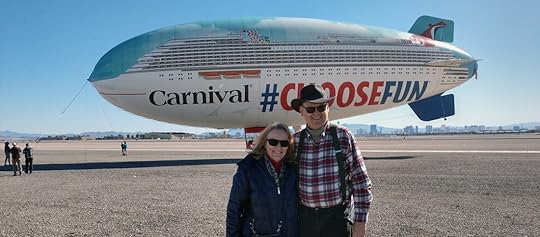
It was difficult for me to contain my delight when I received an invitation to take a ride in a blimp. A blimp! Really? I have been entranced with lighter-than-air flying machines since I saw one flying over the Rose Parade when I was a kid. Yes! I wrote back immediately. I would love to take a ride in a blimp! I restrained myself from adding extra exclamation marks, but seriously… a blimp!!!
This blimp is Carnival Cruise Line’s #ChooseFunAirShip, commissioned to celebrate the arrival of the new Carnival Panorama cruise ship in Long Beach, California. A picture of the Panorama covers the sides of the 128-foot-long blimp, making it the perfect ambassador for the real ship.
So here’s what it’s like to ride in the AirShip. The first thing we needed to know was that the weight limit for pilot and passengers is 500 pounds. So that means the maximum payload is three or four people, depending on their heft. But the other thing the blimp operators have to keep in mind is that if the blimp is not heavy enough, it will fly away on its own. It’s basically a giant football-shaped helium balloon with some motors, rudders, and a little cabin attached.
I waited while a person on the previous flight got out. I climbed in, and the second previous passenger climbed out. The process was repeated, keeping the weight in the cabin roughly the same. The crew adds ballast if it’s needed. Crew members were also holding tightly to tethers.
Fortunately, the weather was perfect: clear and calm. We put on headsets and listened to air traffic control. The pilot explained the rules he has to follow to keep the FAA happy. Basically, he wants to fly as low as possible so people on the ground can see and read the blimp. The sweet spot is between one and two thousand feet, so we rose that high in a matter of moments, and then chugged out toward Red Rock Canyon. The ride was smooth, and it was magical to see the whole valley spread out below us, the Strip to the south, and snow-capped mountains to the west and north.
Although equipped with up-to-the minute instrument panel and motors, the AirShip still has the feel of a Victorian flying machine. I couldn’t help fantasizing about a low, slow trip around the world. If Las Vegas is fascinating from a quarter mile up, think how terrific it would be to check out Tokyo, Paris, or Istanbul. Especially if you could get off the blimp and take the Panorama across the all the oceans.
As I mentioned above, Carnival’s AirShip is emblazoned with the slogan #CHOOSEFUN. Nothing says fun like a blimp, and I thought that even before I got to be a passenger. Thanks, Carnival for choosing me to have a chance to see a blimp from the inside, to get a panoramic view of my favorite city, and to join the celebration surrounding the Panorama’s arrival in Long Beach. The AirShip, continuing its year-long tour, has now flown east to Phoenix.
Click to view slideshow.
The post Blimp Cruise Over Vegas appeared first on Megan Edwards.



